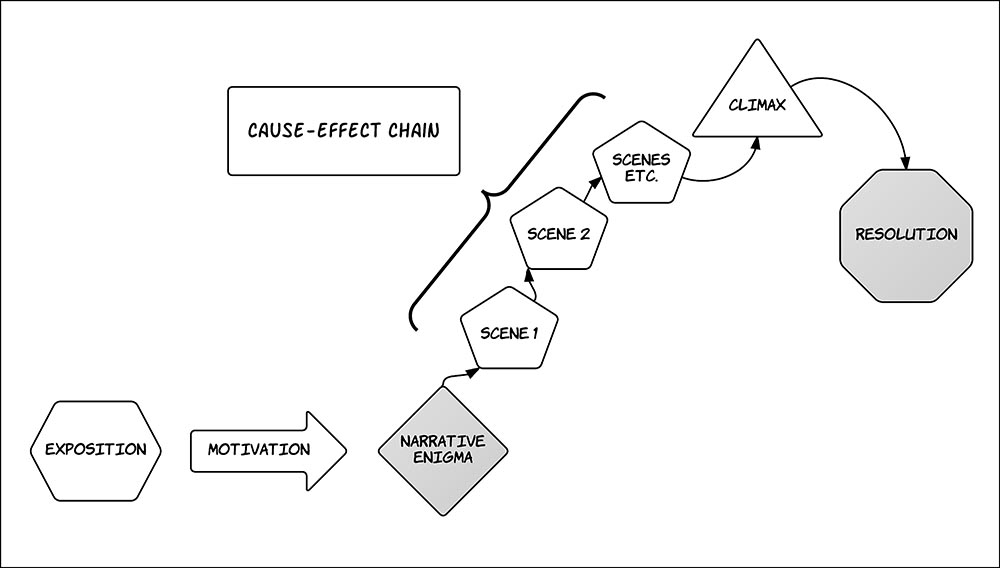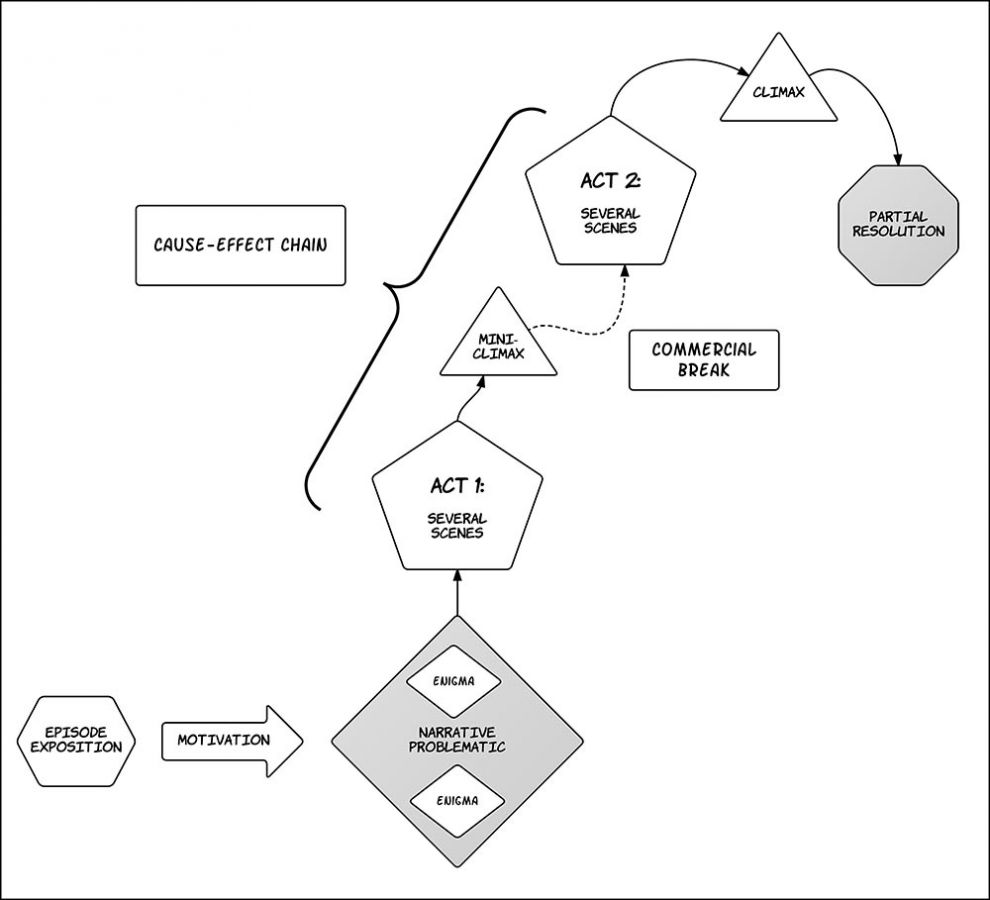|
|
| Line 1: |
Line 1: |
| − | {{Gallery
| + | ==Classical Hollywood cinema== |
| − | |title=''Vivre sa Vie'' ([http://www.tcf.ua.edu/Classes/Jbutler/T577/Godard_Criticism_Brecht.php additional illustrations])
| + | <gallery mode="packed" heights=600px> |
| − | |width=400
| + | File:Narrative Structure - Classical Film.jpeg|alt=Diagram of classical narrative structure.|''Television'' Figure 3.6 The rise and fall of the narrative action in classical film. |
| − | |lines=1
| + | </gallery> |
| − | |align=center
| |
| − | |File:VivreSaVieqq00_33_10qq00001.jpg|alt1=Nana looks down.|Nana looks down.
| |
| − | |File:VivreSaVieqq00_33_12qq00002.jpg|alt2=Nana looks directly at the camera.|Nana looks directly at the camera.
| |
| − | |File:VsV081.jpg|alt3=The look of a prostitute.|The look of a prostitute.
| |
| − | |File:VsV071bOvalPortrait.JPG|alt4=Luigi and Poe's ''Complete Works''.|Luigi and Poe's ''Complete Works''. | |
| − | }}
| |
| | | | |
| − | '''MacCabe & Mulvey''' | + | Does ''Always Be My Maybe'' fit the classical implementation of: |
| | | | |
| − | #'''Whole class:''' MacCabe and Mulvey present a complicated argument about the film, ''Numero Deux'', contending that it is primarily about "the effects of capitalism on sexual relations and the oppression of the working class..." They also link "the oppression of capitalism and the alienation of sexuality." | + | #Single protagonist |
| − | #*How does Godard represent the ''economics'' of prostitution in ''Vivre sa vie''? That is, how would you characterize the way that the ''economic'' activity of Nana and the other prostitutes? Are they economically "''oppressed''"? | + | #Exposition |
| − | #*How does Godard represent the ''sexuality'' of prostitution in ''Vivre sa vie''? That is, how would you characterize the way that the ''sexual'' activity of Nana and the other prostitutes? Is it "''alienated''"? | + | #Motivation |
| − | #**You may find it useful to compare Godard's prostitute with prostitutes from other films, such as ''Pretty Woman''. | + | #Narrative enigma |
| − | #MacCabe and Mulvey contend, "Female nakedness carries associations of the exploitation of women that almost no degree of formal subversion can displace." | + | #Cause-effect chain |
| − | #*'''All Groups:''' What do they mean by "formal subversion"? They focus on Godard's ''British Sounds'' and the scene of a woman walking up/down stairs ([http://www.tcf.ua.edu/Classes/Jbutler/T340/BritishSounds.htm see frame grabs]). How does this scene supposedly illustrate this "subversion." Is sexuality "demystified," as MacCabe and Mulvey discuss? | + | #*''Story time'' versus ''screen time''--in terms of duration and order |
| − | #*Consider the instances of "female nakedness" there are in ''Vivre sa vie'' — especially the one of the nude woman looking at the camera ([http://www.tcf.ua.edu/Classes/Jbutler/T577/Godard_Criticism_Brecht.php see frame grabs]). Is there formal subversion occurring there? | + | #Climax |
| − | #**'''All Groups:''' Do you think it is possible to use a naked female body in a film in such a way that it is not exploitative? Explain, and provide an example (either from a film or hypothetical). | + | #Resolution |
| | | | |
| − | '''Godard, Brecht & Wollen'''
| + | ==The television series== |
| | | | |
| − | #'''All Groups:''' Describe at least three ways in which ''Vivre sa Vie'' incorporates Brechtian and/or counter-cinema techniques. What impact do these techniques have? What argument would Godard make for using them in a film such as ''Vivre sa Vie''? In other words, what's the point?
| + | <gallery mode="packed" heights=600px> |
| − | #*Start with the image of Nana looking at the camera.
| + | File:Fig03-12 TV Series Narrative Structure - rendered.jpg|alt=Diagram of series-TV narrative structure.|''Television'' Figure 3.12 Linear-TV series' narrative structure must accommodate commercial interruptions and allow for a repeatable narrative problematic. |
| − | #'''All Groups:''' Does ''Vivre sa Vie'' seem more "Brechtian" or more counter cinema than ''Breathless''? Why or why not? What do you imagine a ''fully'' counter-cinema film would look and sound like? As a group, plan your own counter-cinema film and be prepared to explain it to the class.
| + | </gallery> |
| − | #Toward the end of the film, Luigi "reads" Poe's "Oval Portrait"; but the voice we hear is Godard's. What parallels are there between Poe's story and Godard's film?
| |
| − | #*And what's with the French subtitles in that scene (see screen shot)?
| |
| | | | |
| − | '''Bibliography''' | + | Break down the "The Vartabedian Conundrum" episode from ''The Big Bang Theory'' (December 8, 2008). Number each scene and provide a ''brief'' description of it. |
| | + | *How many scenes does it have? |
| | | | |
| − | #Brecht, Bertolt. "The Modern Theatre is the Epic Theatre." In ''Brecht on Theatre'', pp. 33-42. Edited and translated by John Willett. New York: Hill and Wang, 1964.
| + | Does the episode contain the conventional elements of a TV series? What are the key differences between its narrative structure and that of a classical film? |
| − | #MacCabe, Colin and Mulvey, Laura. "Images of Woman, Images of Sexuality, in ''Godard: Images, Sounds, Politics'', 79-101. Bloomington, IN: Indiana University, 1980. | + | #Multiple protagonists |
| − | #Wollen, Peter. "Godard and Counter Cinema: VENT D'EST." In ''Readings and Writings: Semiotic Counter-Strategies''. London: Verso, 1982. | + | #Exposition |
| | + | #Motivation |
| | + | #Narrative problematic |
| | + | #Cause-effect chain |
| | + | #Climax |
| | + | #Resolution? |
| | | | |
| − | ==External links==
| + | [[Category:BUI301F2022]] |
| − | *[http://www.tcf.ua.edu/Classes/Jbutler/T340/BritishSounds.htm ''British Sounds'' illustrations]
| + | [[Category:BUI301F2022 Discussion]] |
| − | *[http://www.tcf.ua.edu/Classes/Jbutler/T577/Godard_Criticism_Brecht.php Godard and Brecht: Godard's Criticism, ''Vivre sa Vie'' & ''Breathless'']
| |
| − | | |
| − | [[Category:TCF340 Discussion]] | |

